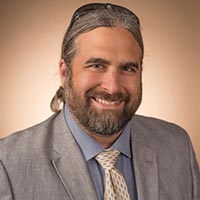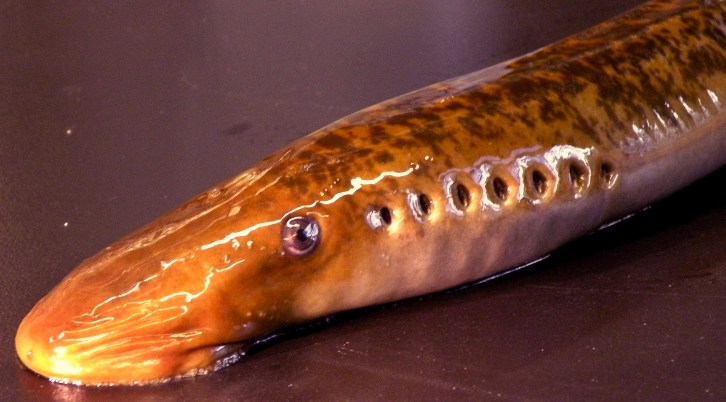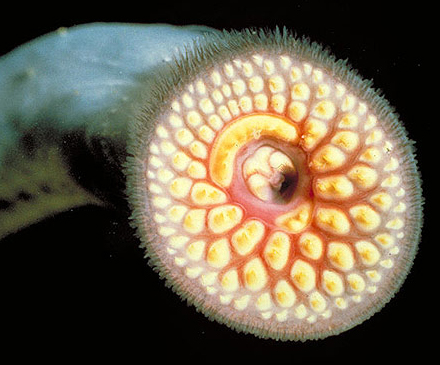2018 NIGMS Director's Early-Career Investigator Lecture
Ancient Bloodsuckers, Disposable Genes, and What It All Means

Jeramiah Smith, Ph.D.
Assistant Professor in Biology
University of Kentucky
Lecture followed by Q&A session
![]() VideoCast of the lecture (live or later)
VideoCast of the lecture (live or later)
Natcher Conference Center (Building 45)
National Institutes of Health
Bethesda, Maryland
Research Summary
Many biologists aim to understand the rules—the molecules and mechanisms that underlie all life on Earth. Jeramiah Smith studies the exceptions. He believes that, in some cases, biological exceptions can be more informative than the rules. They can also be more interesting.
Smith, a biologist at the University of Kentucky, focuses on genetically exceptional organisms. One of his favorites is a leech-like creature called the sea lamprey.

Lampreys possess one of nature’s most enviable traits—the ability to repair an injured spinal cord. Humans with spinal cord injuries are often paralyzed and lose bowel and bladder control. In contrast, lampreys regain all their normal functions, swimming within 12 weeks, even after their spinal cords are completely severed.
Genetically speaking, lampreys are also highly unusual. Most animals guard their genomes zealously. After all, altering a single letter of our DNA code could cause a devastating genetic disease or set the stage for cancer. Lampreys, meanwhile, toss out a full 20 percent of their DNA while they are still embryos.
This remarkable process is called programmed genome rearrangement (PGR). Some researchers, including Smith, suspect that it might help protect lampreys from cancer.
All animals have genes that are active during early development, long before tissues and organs are formed. Under normal circumstances, most animals permanently switch off (“silence”) these genes once they’re no longer needed.
Unfortunately, due to cellular errors, silenced genes can occasionally be switched back on. Reactivating certain silenced genes can contribute to the development of cancer. By permanently disposing of unnecessary genes, rather than merely silencing them, lampreys eliminate the risk that these genes would be activated and lead to cancer.
As a result of PGR, lampreys have two genomes. The complete genome contains 99 pairs of chromosomes and is found only in reproductive (germline) cells—eggs and sperm. The other, a slimmed-down, post-PGR genome, is found in all other cells of the lamprey’s body.

As one of the first organisms to have a backbone, the sea lamprey is considered a “living fossil.” It is also considered a delicacy in several European and Asian countries. In the Great Lakes, it is a parasitic pest that has decimated trout populations. Courtesy: Wikimedia Commons, U.S. Environmental Protection Agency
By combining a variety of techniques, Smith and his colleagues sequenced both lamprey genomes. This work enabled the researchers to identify which genes allow lampreys to regrow severed spinal cords. It turns out that mammals, including humans, also have these genes, but use them differently.
Lampreys sit on an unusual branch of the evolutionary tree. Called jawless fish, they split off more than 500 million years ago from other vertebrates (the group of animals that includes mammals, bony fish, birds and reptiles). Because they are ancient members of the vertebrate family, lampreys can help scientists understand which genes and traits are essential to all vertebrates. They also highlight which cellular processes—such as spinal cord regeneration and PGR—were lost during evolution of the majority of vertebrates.
By studying lamprey genomics, Smith’s team aims to understand what PGR reveals about vertebrate evolution, cancer biology, and the genetic rules of our own species.
References:
Smith JJ, Timoshevskaya N, Ye C, Holt C, Keinath MC, Parker HJ, Cook ME, Hess JE, Narum SR, Lamanna F, Kaessmann H, Timoshevskiy VA, Waterbury CKM, Saraceno C, Wiedemann LM, Robb SMC, Baker C, Eichler EE, Hockman D , Sauka-Spengler T, Yandell M, Krumlauf R, Elgar G, Amemiya CT. The sea lamprey germline genome provides insights into programmed genome rearrangement and vertebrate evolution. Nat Genet. [Internet] 2018 Feb; 50(2):270-277. Available from:
https://www.nature.com/articles/s41588-017-0036-1 doi: 10.1038/s41588-017-0036-1
Herman PE, Papatheodorou A, Bryant SA, Waterbury CKM, Herdy JR, Arcese AA, Buxbaum JD, Smith JJ, Morgan JR, Bloom O. Highly conserved molecular pathways, including Wnt signaling, promote functional recovery from spinal cord injury in lampreys. Sci Rep. [Internet] 2018 Jan 15; 8(1):742. Available from:
https://www.nature.com/articles/s41598-017-18757-1 doi: 10.1038/s41598-017-18757-1
Biographical Sketch
Up Close With
Jeramiah Smith
Favorite Food:
Almost anything new, especially if it has coconut.
Favorite Sport:
Fishing.
Favorite Song:
Spoonman (Soundgarden)
If He Wasn't a Scientist, He Would Be:
Fishing
Smith crisscrossed the U.S. during his scientific training in biology. He received a bachelor’s degree from Black Hills State University in his home state of South Dakota, a master’s degree from Colorado State University, and a Ph.D. from the University of Kentucky. He worked as a postdoctoral fellow at the University of Washington and Benaroya Research Institute, both in Washington State. In 2011, he returned to the University of Kentucky as a faculty member.
So far, Smith has coauthored 40 papers. His January 2018 Nature Genetics paper presents the first genome sequence of the sea lamprey germline. He has served as a reviewer for some 20 academic journals, including Nature, Nature Genetics, eLife, Current Biology and Genome Research.
Smith speaks frequently across the continental U.S., and has also presented scientific talks in Puerto Rico, Japan, China, Columbia, and Brazil.
Dedicated to inspiring future scientists, Smith has hosted high school interns and mentored undergraduates, graduate students, and postdoctoral fellows in his lab. He has explained his work to middle school students, visiting scholars, international students—basically, as he says, “almost anyone who will listen.” If you’re ever in Lexington, KY and want to see what a lamprey looks like, he would gladly show you one.
NIGMS has supported Smith’s research under grant R01GM104123 since 2013.
